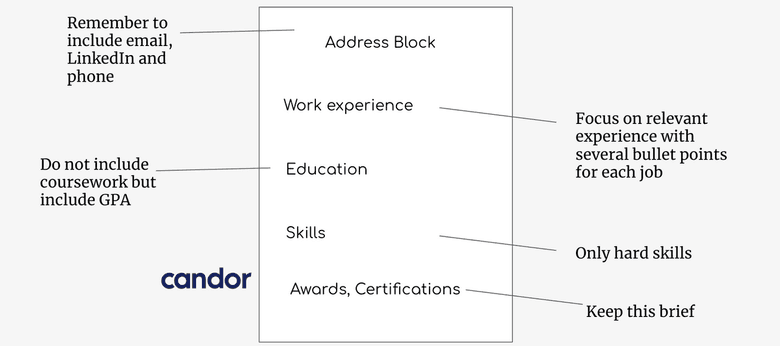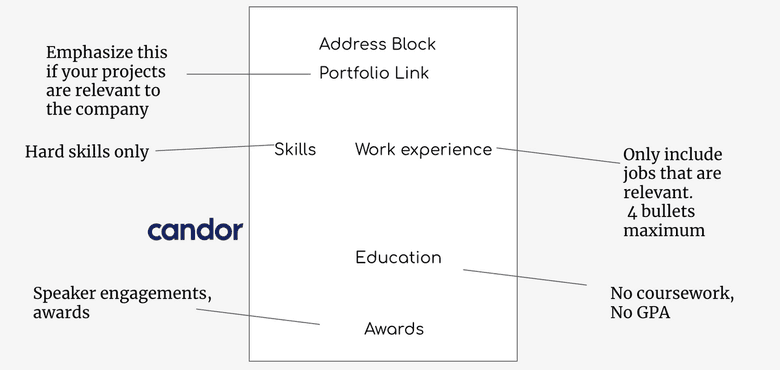Which resume outline should you use?
It's crucial to use the right resume outline for your career situation.
A recruiter will only look at your resume for 6 seconds, on average.
Therefore, it's crucial that you use the right resume outline to make it easy for the recruiter to visually scan and easily find key components. This is not the place to get super creative - stick to a resume format that is proven to get job seekers noticed for the right reasons.
So what does that format look like?
How to Make a Resume Outline
First, think about the information hierarchy. This is a fancy way of saying: write things in the order you want the recruiter to read them. You should think about this before you even sit down to write your resume, or look at resume examples on the internet. Why?
You want to highlight the elements that make you a good fit for the job, among thousands of job seekers who probably applied. To do this, think about what would stand out to the hiring manager. After all, a good resume is one that will market you the most effectively.
Start by answering these three questions:
- What are my most relevant skills and job experience?
- Does my schooling or coursework make me competitive?
- Do I have any hard skills that are very difficult to acquire?
If something from your past experience makes you stand out, this is what you should use to make a strong first impression.
What Your Outline Should Look Like
Resume writing advice is full of harmful information, so let me say this upfront: what your resume looks like will depend on your competitive advantage. Stop following resume templates unless you can clearly identify why they apply to your specific case.
All resume outlines should include these sections:

While something like work history is required for everyone, other resume sections like volunteer work or hobbies are both not required and not recommended.
Let's look at some outline examples for different scenarios and levels of professional experience.
For Recent Graduates...
Your resume outline should look like this:

The following points are important to reiterate:
- Make sure you mention relevant coursework, not all the classes you're taking. Customize this for the job
- If you don't have any special projects, you can substitute with a summary statement.
- You want to use a chronological resume format for your work experience and list enough to fill the page, even if not relevant.
For Junior Professionals...
Your resume outline should look like this:

Make sure you do the following:
- Include a LinkedIn profile, email, and phone number, but skip your street address
- Start pairing down your work experience to relevant jobs only
- Focus on the top accomplishments, using 3 bullet points maximum per job description
- Do not put coursework, but include GPA in the education section
- Do not add soft skills, just hard skills (like programming languages or software applications)
- You can add awards or volunteer experience, but keep it short - this should not be a bulleted list.
For Career Switchers...
Use a resume summary. If you're changing careers, the best resume is one that addresses that head-on. This is one of few resume formats that should use a resume summary or objectives section. Put some thought into this. It should feel like a mini cover letter, orienting the recruiter on how to sell you to the hiring manager. Emphasize points that will help you with this new career path.
Your resume outline should look like this:

Top resume building tips for career switchers:
- Emphasize the skills section and the education section, if they make you a better fit for the new career than your current work experience.
- Include any additional coursework, like Coursera, Udemy, or Bootcamps that enhance relevant skills.
- Have a strong resume heading. Address your transition in the summary section with 3-4 sentences.
- Don't be afraid of using reverse chronological order, or skipping jobs to make yourself stand out.
- If you've worked for impressive brands, emphasize the name of the company, not your job title.
For Heavily Technical Roles...
Your resume outline should look like this:

In professional resumes, the emphasis is on showing tangible proof you're qualified. This might mean projects you've done that are technically complex or skills you have that are hard to acquire.
Tips for technical professionals:
- Put your portfolio front and center in the resume objective area. Make it a focal point if the work is relevant to the company you're applying for.
- Place equal emphasis on your job experience and hard skills.
- Soft skills should only be present in the bullet points, not called out separately.
- In the education section, skip the details and just list your major.
- List awards and speaking engagements on the bottom, only if you have room.
Be Careful With Resume Templates
Free resume templates are tempting to download and fill out, especially when you're pressed for time. However, these are never one-size-fits-all. Spend some time building a strategy and picking the right outline for you. Not all professional resumes are built the same. While some staples like your contact information are required, other resume sections like the objectives are only necessary for some.
The best resumes take your individual circumstances into account to help you make the right first impression with the recruiter and hiring manager.
The information provided herein is for general informational purposes only and is not intended to provide tax, legal, or investment advice and should not be construed as an offer to sell, a solicitation of an offer to buy, or a recommendation of any security by Candor, its employees and affiliates, or any third-party. Any expressions of opinion or assumptions are for illustrative purposes only and are subject to change without notice. Past performance is not a guarantee of future results and the opinions presented herein should not be viewed as an indicator of future performance. Investing in securities involves risk. Loss of principal is possible.
Third-party data has been obtained from sources we believe to be reliable; however, its accuracy, completeness, or reliability cannot be guaranteed. Candor does not receive compensation to promote or discuss any particular Company; however, Candor, its employees and affiliates, and/or its clients may hold positions in securities of the Companies discussed.
